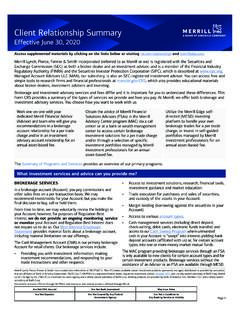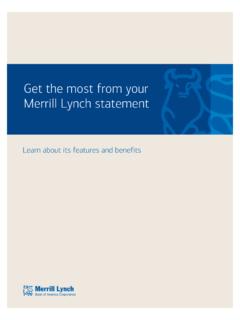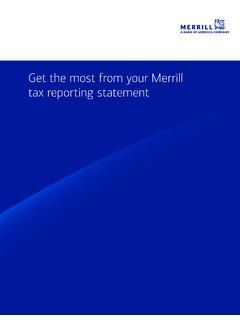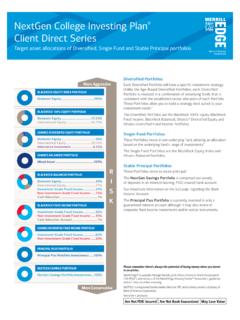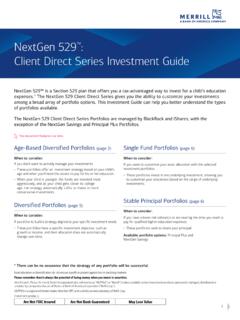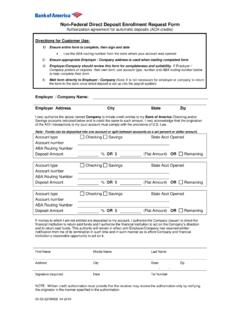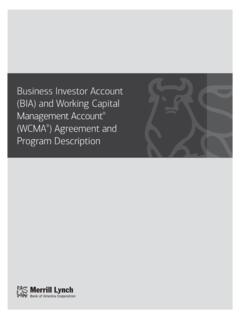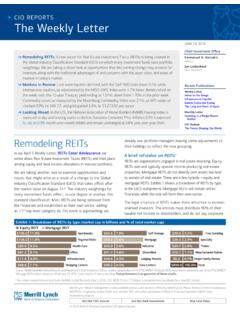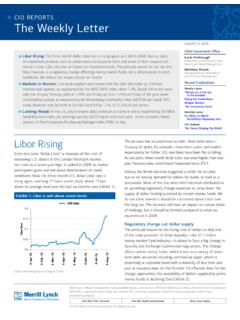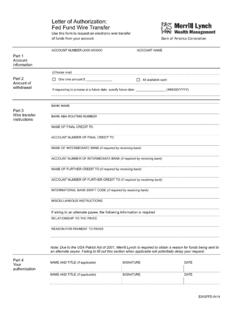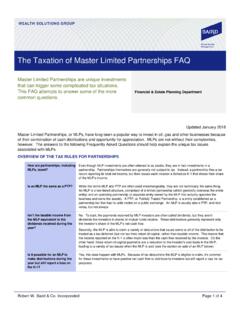Transcription of Margin Handbook - Merrill
1 Margin HandbookMerrill Edge Self-DirectedMargin Risk Disclosure StatementIn accordance with requirements of FINRA, Merrill is furnishing this Margin Risks Disclosure Statement. This document will provide some basic information about purchasing securities on Margin and alert you to the risks involved with maintaining a Margin account. Merrill refers to Margin as the Margin lending program. When you purchase securities, you may pay for the securities in full, or if your account has been established as a Margin account with the Margin lending program, you may borrow part of the purchase price from Merrill , thereby leveraging your investment . If you choose to borrow funds for your purchase, Merrill s collateral for the loan will be the securities purchased, other assets in your Margin account and your assets in any other accounts at Merrill other than retirement accounts (such as IRAs). If the securities in your Margin account decline in value, so does the value of the collateral supporting your loan, and, as a result, we can take action, such as to issue a Margin call and/or sell securities in any of your accounts held with us, in order to maintain the required equity in your account.
2 If your account has a Visa card and/or checks, you may also create a Margin debit if your withdrawals (by Visa card, checks, preauthorized debits, FTS or other transfers) exceed the sum of any available free credit balances plus available money account balances (such as bank deposit balances or money market funds). Please refer to your account documents for more information. Also note that it may be more advantageous to pay cash than to use Margin for smaller securities purchases. On smaller securities purchases, a higher percentage of the transaction cost goes to commissions and interest charges, which are generally higher on smaller balances. The commissions plus interest charges could equal or exceed any appreciation in your securities. Before opening a Margin account, you should carefully review the terms governing Margin loans. For Individual Investor Accounts, these terms are contained in the Margin Lending Program Client Agreement. For all other accounts, the terms are in your account agreement and disclosures.
3 It is important that you fully understand the risks involved in using Margin . These risks including the following: You can lose more funds than you deposit in the Margin account. A decline in the value of securities that are purchased on Margin may require you to provide additional funds to us to avoid the forced sale of those securities or other securities or assets in your account(s). We can force the sale of securities or other assets in your account(s). If the equity in your account falls below the maintenance Margin requirements or Merrill s higher house requirements, we can sell the securities or other assets in any of your accounts held by us to cover the Margin deficiency. You also will be responsible for any shortfall in the account after such a sale. We can sell your securities or other assets without contacting you. Some investors mistakenly believe that they must be contacted for a Margin call to be valid, and that securities or other assets in their accounts cannot be liquidated to meet the call unless they are contacted first.
4 This is not the case. We will attempt to notify you of Margin calls, but we are not required to do so. Even if we have contacted you and provided a specific date by which you can meet a Margin call, we can still take necessary steps to protect our financial interests, including immediately selling the securities or other assets without notice to you. You are not entitled to choose which securities or other assets in your account(s) are liquidated or sold to meet a Margin call. Because the securities or other assets are collateral for the Margin loan, we have the right to decide which securities or other assets to sell in order to protect our interests. We can increase our house maintenance Margin requirements at any time and are not required to provide you advance written notice. These changes in our policy may take effect immediately and may result in the issuance of a maintenance Margin call. Your failure to satisfy the call may cause us to liquidate or sell securities in your account(s).
5 You are not entitled to an extension of time on a Margin call. While an extension of time to meet Margin requirements may be available to you under certain conditions, you do not have a right to the extension. If you have any questions or concerns about Margin and the Margin lending program, please contact the Merrill Edge Self-Directed investment InformationPlease remember there s always the potential of losing money when investing in securities. The following information is intended for Merrill Edge Self-Directed clients to learn more about Margin trading rules and requirements, especially for trades entered online through Merrill Edge Self-Directed clients may contact the investment Center at with questions about the Merrill Edge Margin Handbook contains information, terminology and requirements associated with Margin trading at Merrill . As a Merrill Edge Self-Directed client, you will have access to your accounts and, if approved, be permitted to enter Margin trades online.
6 We believe you should have a basic understanding of Margin prior to entering trades involving the extension of credit. Please note that the examples contained in this Handbook do not include commissions, Margin interest, account fees or any other fees associated with your Merrill Edge Self-Directed Lynch, Pierce, Fenner & Smith Incorporated (also referred to as MLPF&S or Merrill ) makes available certain investment products sponsored, managed, distributed or provided by companies that are affiliates of Bank of America Corporation ( BofA Corp. ). MLPF&S is a registered broker-dealer, registered investment adviser, Member SIPC and a wholly owned subsidiary of BofA products are provided by Bank of America, , and affiliated banks, Members FDIC and wholly owned subsidiaries of BofA products: 2022 Bank of America Corporation. All rights reserved. | MAP4305551 | BRO-02-22-0256 | 02/2022 Are Not FDIC InsuredAre Not Bank GuaranteedMay Lose ValueTable of ContentsMargin Basics 1 What Is Margin ?
7 1 Cash vs Margin Accounts 2 Advantages and Risks of Using Margin 3 Short Selling 4 Securities Eligible for Margin 6 Margin Requirements 7 Equity Margin Values 8 Stock/ETF Margin Requirements 12 Concentrated Stock/ETF Requirements 13 Fixed Income Margin Requirements 14 Margin Calls 14 Satisfying Margin Calls 14 Day Trading 15 What Is Day Trading?
8 15 Day Trading Requirements 15 Day Trade Call 17 Trading Violations 18 Violations Overview 18 Freeriding Violation Cash Accounts 18 Technical Violation Cash Accounts 19 Technical (Liquidation) Violation Margin Accounts 19 Sale-Not-Long Violation Cash Accounts 20 Unmet Day Trade Call (Day Trade Violation) 20 Restrictions 20 FAQs 21 Important Margin Definitions 221 What Is Margin ?
9 A Margin account is a loan account Margin is an extension of credit by Merrill using marginable securities held as collateral You can use Margin loans to purchase additional securities or withdraw funds for other purposes Margin accounts can also be used for short selling securities Merrill refers to Margin as the Margin Lending Program Margin interest is charged on the amount of money you borrow based on how much time the loan is outstanding Margin interest rates are based on your total loan amount and are subject to change Current Margin rates are available online The amount of money that can be borrowed and the terms of the Margin Lending Program are governed by the Board of Governors of the Federal Reserve System, the Securities and Exchange Commission (SEC), the Financial Industry Regulatory Authority (FINRA) and Merrill To be considered for a Margin account, you must apply at account opening or separately using the Margin Lending Program Application and Agreement and maintain at least $2,000 in equity through the deposit of cash or marginable securities After you have met the minimum requirements, initial equity will be based on the Regulation T (Reg T)
10 Requirement, which is currently 50% of the purchase price of most securities This means that if you wish to purchase $15,000 of a marginable security, you could pay $7,500 and borrow the remaining $7,500 from Merrill You will be charged Margin interest on the amount you borrow After the initial requirements have been met, certain minimum maintenance equity requirements apply to Margin accounts Merrill generally applies a maintenance requirement equal to 30% of the current market value, in the case of fully marginable equity securities Requirements change based on the types of positions held in the account Please note that Margin requirements are based on the market value of a security Therefore, a decline in the price may result in a higher maintenance requirement for the position and may subsequently create a maintenance call in the account Securities that fall below certain dollar thresholds are subject to higher maintenance Margin requirements (See Stock/ETF Margin Requirements)
